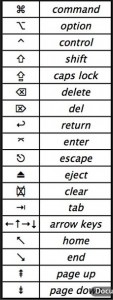A tool is a device that can be used to produce an item or achieve a task, but that is not consumed in the process. Informally the word is also used to describe a procedure or process with a specific purpose. Tools that are used in particular fields or activities may have different designations such as Instrument, Utensil, Implement, Machine, or Apparatus. ~ Wikipedia
“Technology is anything that was invented after you were born.” ~ Alan Kay
Technology is so pervasive in our lives that it is nearly impossible to grasp. If we consider all the innovations within the time of human development, we would have to include fire, the wheel, and even culture itself. With a scope so large it becomes very difficult to summarize. As we consider present-day techniques (technology adoption), it is helpful to acknowledge this long history. The fact that we use the tools we have inherited and use in unconscious ways (tools, technology and methods of mental organization) is a testament to our ability to adapt. We are capable (required really) of adopting new tools and methods, use them and forget what and how we learned them. We also forget that we “stand on the shoulders of the giants” who developed these tools. Habits are just that; routines that we have committed to physical and mental memory. Behavior that comes “naturally”.
While this blog is devoted to a broad range of tools, this series of posts explores the “cutting edge” of technology; which requires effort, makes us uncomfortable and requires choice. I am interested in the influence that technology has in our lives. Old and young, business-women and house-husband, teacher, developer, grandparent, and small child. Whether we like it or not, we are pushed and pulled by technology. I want to understand the influence that technology, digital tools, has on us. It makes sense that understanding the irritations and benefits of digital tools can help us choose more wisely. That is the crux of my exploration.
Most familiar to me are the basic digital tools that help us communicate with each other and organize our interests and work. I admit I have drank from the fire hose of technology at times. Sometimes this force feeding has been required within the responsibilities of my job. Sometimes I’ve chosen to explore some new tool and sometimes I’ve simply gotten carried away.
Digital technology and it’s adoption can be informed by other (non-electronic) technologies and applications. There are diverse aptitudes and inclinations for tools of various kinds. The woman who can’t begin to use a computer may have mechanical aptitude, woodworking aptitude, horticultural aptitude, social aptitude. Remembering the arc of innovation that preceded the “digital revolution” can help us understand common threads between the development of digital and traditional tools. Familiar, traditional trades and tools shaped the people who designed the first computers. Familiarity with hand tools, art and craft were an asset to developing skill with digital tools, giving the developers confidence and a model of practice. While there may be many examples of people for whom one aptitude fails to inform the other, skill in one field can inform another. For example, I know a number of musicians that are incredibly versatile with technology. When I help someone understand their computer I try to employ their other skills in the process.
I began this series of posts with a quote from Kevin Kelly:
“I began this book with a quest for a method, an understanding at least, that would guide my choices in the technium. I needed a bigger view to enable me to choose technologies that would bless me with greater benefits and fewer demands.”
Kelly’s sentiment spoke to me, in part because I rely so heavily on technology in my work. More generally it speaks to my desire to find balance for myself and the people I support. My mental and physical health improve when I am observant and disciplined in my practices. Given the amount of time I spend with my computer, phone, camera and other devices, managing them well will improve my quality of life. As a bonus, managing my personal use can help me help others lead a more sane digital life. I must admit that observing others is a great source of entertainment and curiosity. While it is sometimes comical to watch people discuss and use their digital tools, it can be painful, even tragic. In this light, my hope is that my exploration of this topic will help me bring understanding and happiness to people as they make digital choices.
A favorite topic of dinner party discussion these days is technology. The conversation begins when someone comments about their new phone and how it helps or confuses them. Someone else offers advice or explains the alternative they prefer. Before long there is an eruption of opinion, emotion and advice on what is best, what is coming, or why one person hates or resists the incessant marketing and development of new technology. While the conversation is somewhat dependent upon the demographic of the group (and the amount of alcohol consumed) any and all social occasions will suffice; a wedding, holiday gathering, reunion, or coffee klatches. Technology adoption is a hot topic of conversation.
While adults (45 and above) are especially uneasy with the innovation around them, everyone feels the push of innovation; propelling us out of our comfort zone and into change. Whether we accept the challenge to adopt the latest technology or not, everyone accepts the trends and the difference between adoption among children and adults. While there are claims of a “digital divide” that separates older luddites from dialed-in youth, I believe these claims are exaggerated. Granted, our children and grandchildren are more willing to pick up the new method or tool. But this willingness does not often translate to insight and knowledge of the tool or trend. The affinity and willingness to adopt is more related to need, desire, lifestyle and priorities. Regardless of age, those who are willing (comfortable) to “play” and experiment advance with more ease.
Technology adoption is more reliant on personal necessity than aptitude. One’s depth of understanding and knowledge of the mechanics of a tool is pushed by a need and is supported by various levels of curiosity and persistence to resolve the need. For example, if my daughter only responds when I send her a text message, I will either learn to text or be frustrated and live in isolation from her. Many adults have learned to text for just this reason. We adapt at various rates as the necessity and/or curiosity hits us. There is no question that our sense of competence with a tool may loom large but I find that desire can help us overcome such bias. As with the texting example, the desire to be in contact/communication with my daughter can be a powerful influence for overcoming my lack of aptitude. If my social status or connection revolves around a system of communication and I don’t adopt that method, I will miss the opportunity of association. What began as a tool for teenagers to connect instantly has evolved into a method of touching our children.
As we continue to explore the imperative to adopt and methods for choosing tools, it is useful to remember the old adage that “necessity is the mother of invention”. It is also the mother of adoption. In this case, the necessity for digital tools is the result of a desire to be connected with one another. While it is important to recognize the unintended consequences that it may have (Turkel, “Alone Together”) belonging is a predominate motivation for technology adoption.




 There are a plethora of keyboard commands listed at
There are a plethora of keyboard commands listed at